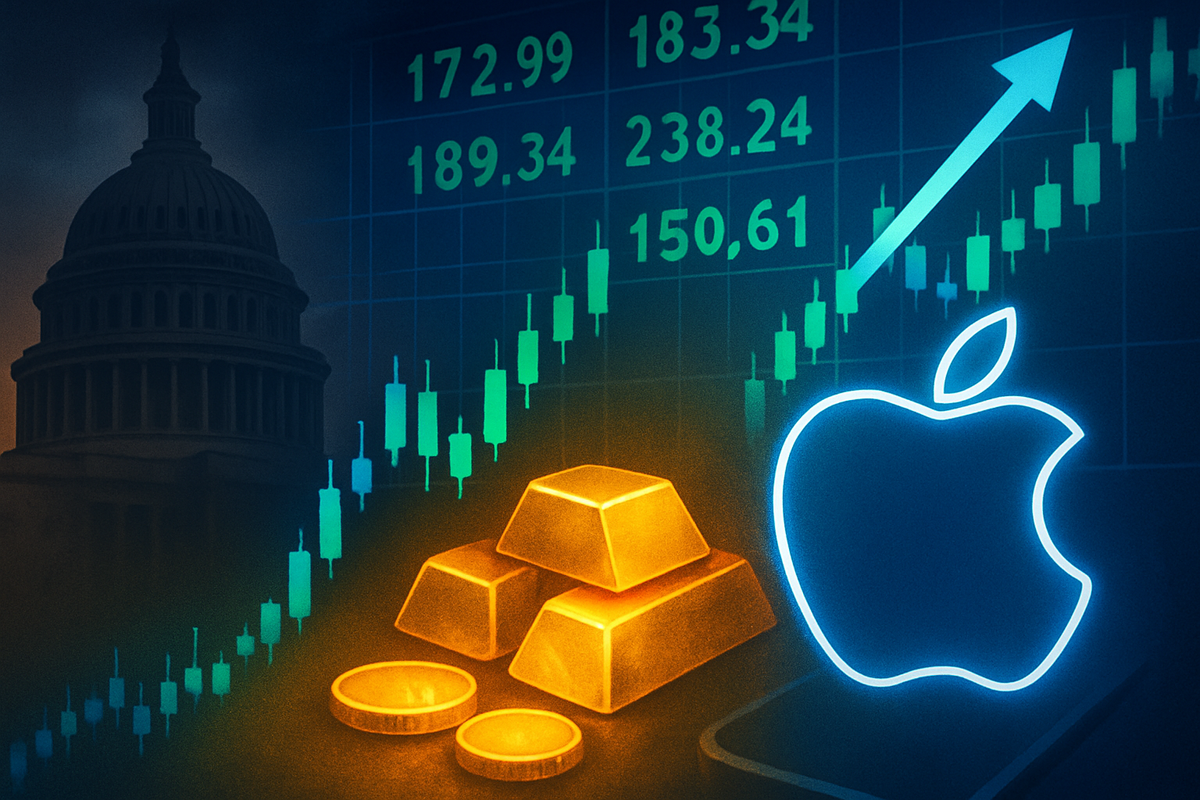
The U.S. financial markets opened the week with a robust performance on October 20, 2025, as the Dow Jones Industrial Average (DJIA) extended its gains, and tech giant Apple Inc. (NASDAQ: AAPL) reached an unprecedented all-time high. This bullish sentiment in equities, however, unfolded against the backdrop of a deepening crisis in Washington, where a 20-day U.S. government shutdown continued to cast a shadow over the economy, simultaneously propelling gold prices to new record highs as investors sought safe-haven assets. The juxtaposition of a thriving stock market and a paralyzed government presents a complex narrative for investors and policymakers alike, highlighting both the market's resilience and its underlying anxieties.
Market Dynamics Amidst Political Turmoil
The Dow Jones Industrial Average demonstrated significant strength, climbing approximately 1.1% in recent trading, with reports indicating a rise of over 450 points to reach 46,488. This strong showing contributes to an impressive 8.7% year-to-date gain for the index, driven by a robust corporate earnings season and persistent optimism for a resolution to the federal impasse. Despite the political gridlock, underlying corporate performance and investor confidence in fundamental economic drivers appear to be providing a strong foundation for equity markets.
Apple Inc. (NASDAQ: AAPL) stole headlines by hitting a new all-time high, with shares reaching an intraday peak of $263.47, surpassing its previous record set in late 2024. The stock traded around $262.42, adding over $10 on the day and pushing its market capitalization to an estimated $3.85 trillion, with a $4 trillion valuation now firmly in sight. This surge is primarily attributed to stellar sales of the new iPhone 17 lineup, which saw a 14% increase over its predecessor in its first ten days, coupled with positive investor sentiment, strategic partnerships like the one with Formula 1, and favorable analyst upgrades from firms like Loop Capital, which set an optimistic price target of $315.
The 20-day federal government shutdown, now the third-longest in U.S. history, has had a profound impact on the commodities market. Gold, traditionally a safe-haven asset, surged to new record highs, with futures jumping 3.6% to $4,365 per ounce and reaching an all-time high of $4,392 before a slight retreat. On October 20, 2025, gold prices settled at $4,347.74 USD per troy ounce, marking a 2.30% increase and an all-time high of $4379.60 in October 2025. The prolonged political stalemate has fueled investor uncertainty, delayed crucial economic data releases (like the jobs report and CPI), and raised concerns about potential GDP impact, all contributing to a flight to safety. The suspension of federal agency operations creates a data vacuum, complicating the Federal Reserve's interest rate decisions and further bolstering gold's appeal amidst a vulnerable economy.
Corporate Fortunes: Winners and Losers in a Volatile Landscape
The current market environment, characterized by Apple's (NASDAQ: AAPL) soaring valuation, a buoyant Dow, and gold's safe-haven rally amidst a government shutdown, creates a distinct landscape of winners and losers among public companies.
Leading the charge are Apple Inc. (NASDAQ: AAPL) itself, which directly benefits from its robust iPhone 17 sales and expanding ecosystem, pushing it closer to a $4 trillion market capitalization. Its success also cascades down to a crucial network of suppliers. Companies like Taiwan Semiconductor Manufacturing Company (TSMC), the primary fabricator of Apple's advanced chips, and Qualcomm (NASDAQ: QCOM), supplying critical 5G components, see their fortunes rise with every iPhone sold. Similarly, Broadcom (NASDAQ: AVGO) (RF modules), Cirrus Logic (NASDAQ: CRUS) (audio and haptics), Hon Hai Precision Industry (Foxconn) (HNHPF) (manufacturing), Murata Manufacturing (OTCMKTS: MRAAY) (capacitors), Texas Instruments (NASDAQ: TXN) (power management), and Corning Inc. (NYSE: GLW) (Gorilla Glass) are all positioned to reap significant rewards from Apple's sustained growth.
Conversely, Apple's dominance puts pressure on its direct competitors. Smartphone rivals like Samsung Electronics Co. Ltd. (SMSN) and Alphabet Inc. (NASDAQ: GOOG, GOOGL) (with its Pixel phones and Android ecosystem) face intensified competition for market share. In the services sector, Spotify Technology S.A. (NYSE: SPOT), a key competitor to Apple Music, could feel the squeeze as Apple's integrated services grow alongside hardware sales. Even fellow tech giants like Microsoft Corp. (NASDAQ: MSFT), while a Dow component and a beneficiary of overall market strength, must contend with Apple's expanding footprint in PCs and potentially AI, drawing investor attention.
The broader rise of the Dow Jones Industrial Average generally signals a healthy environment for its 30 constituent companies. This includes titans like UnitedHealth Group Incorporated (NYSE: UNH), Goldman Sachs Group, Inc. (NYSE: GS), Home Depot, Inc. (NYSE: HD), Visa Inc. (NYSE: V), JPMorgan Chase & Co. (NYSE: JPM), Caterpillar Inc. (NYSE: CAT), Amgen Inc. (NASDAQ: AMGN), Salesforce, Inc. (NYSE: CRM), Honeywell International Inc. (NASDAQ: HON), Merck & Co., Inc. (NYSE: MRK), Coca-Cola Company (NYSE: KO), Walmart Inc. (NYSE: WMT), and recently added Amazon.com, Inc. (NASDAQ: AMZN). These established companies benefit from increased investor confidence and capital inflows, leading to higher valuations. Brokerage and financial services firms such as Charles Schwab (NYSE: SCHW) and Morgan Stanley (NYSE: MS) also see increased revenue from higher trading volumes and asset management fees.
However, the prolonged government shutdown creates a distinct set of losers. Businesses heavily reliant on federal contracts face immediate disruptions, including halted payments and delayed new awards. Small businesses, particularly those operating near federal installations or dependent on government-backed loans, suffer from reduced consumer spending by furloughed workers and administrative bottlenecks. Companies requiring federal permits, regulatory approvals, or critical data from government agencies also experience significant delays, hindering their operational efficiency and growth prospects. Furthermore, industries sensitive to overall consumer confidence, such as discretionary retail and travel (e.g., Delta Air Lines (NYSE: DAL) and United Airlines (NASDAQ: UAL)), could see reduced demand as economic uncertainty persists.
On the flip side, the safe-haven demand for gold, driven by the shutdown-induced uncertainty, presents a boon for gold mining companies. Major players like Newmont Corporation (NYSE: NEM), Barrick Gold (NYSE: GOLD), Agnico Eagle Mines (NYSE: AEM), Kinross Gold (NYSE: KGC), Franco-Nevada (NYSE: FNV), AngloGold Ashanti (NYSE: AU), and Gold Fields (NYSE: GFI) are direct beneficiaries, as higher gold prices translate into increased revenues and expanded profit margins. Gold-backed exchange-traded funds and investment funds also see their asset values appreciate significantly, attracting capital from risk-averse investors.
Wider Significance: Navigating a Bifurcated Market
The current financial landscape, characterized by surging equities and a government in paralysis, paints a complex picture of broader industry trends and economic implications. Apple's (NASDAQ: AAPL) remarkable ascent to an all-time high is not an isolated event but rather indicative of the enduring dominance of the tech sector, particularly companies deeply embedded in the burgeoning artificial intelligence (AI) boom. Apple's strategic shift to custom silicon and its privacy-centric, on-device AI approach are influencing industry standards, while strong sales of its iPhone 17 underscore robust consumer demand for cutting-edge technology. This trend, often highlighted by the performance of the "Magnificent Seven" tech giants, suggests a continued investor confidence in technological innovation as a primary growth driver.
However, this market exuberance coexists with signs of an uneven economic recovery. While the Dow Jones Industrial Average shows healthy year-to-date gains, much of the market's appreciation remains concentrated in a few mega-cap companies. A softening labor market, with unemployment ticking up, suggests that the economic benefits are not uniformly distributed, contributing to the Federal Reserve's dovish stance on interest rates. Lingering geopolitical tensions and renewed US-China trade frictions further compound global uncertainty, driving investors towards perceived safe havens.
The ripple effects of these dynamics are significant. Investor sentiment is caught between the allure of strong corporate performance and the apprehension caused by political instability. This dichotomy is clearly visible in the simultaneous rally of both equities and gold, indicating that investors are both seeking growth opportunities in quality assets like Apple and hedging against broader economic and political risks with precious metals. The 20-day government shutdown, now a significant economic drag, directly reduces GDP growth, furloughs hundreds of thousands of federal workers, delays critical government services, and severely impacts small businesses reliant on federal contracts or loans. Furthermore, the absence of crucial economic data during the shutdown complicates the Federal Reserve's ability to make informed monetary policy decisions, creating a period of policy limbo and potential market volatility.
From a regulatory and policy perspective, the situation presents several challenges. The Federal Reserve faces a dilemma, needing accurate economic data to guide potential interest rate cuts, yet deprived of it by the shutdown. This could lead to delayed or less precise policy responses. The prolonged shutdown itself underscores a recurring failure of fiscal policy, highlighting deep divisions in Congress and eroding public confidence in governance. This will undoubtedly intensify debates around government spending, budget deficits, and the need for more stable funding mechanisms. Moreover, the increasing market concentration driven by mega-cap tech companies like Apple raises questions about potential antitrust concerns and the need for greater market oversight to ensure fair competition and prevent systemic risks.
Historically, US government shutdowns have consistently demonstrated negative economic impacts, with previous prolonged shutdowns leading to billions in lost GDP and widespread disruptions. The current 20-day shutdown is among the longest, exacerbating these concerns. Gold's role as a safe haven is also well-established; while shorter shutdowns might have a limited impact, the unprecedented length and uncertainty of the current shutdown have amplified its appeal, leading to a substantial rally. Interestingly, stock market rallies have sometimes occurred amidst economic headwinds, often driven by specific strong sectors or anticipation of policy shifts. However, sustained political instability typically increases market volatility. This current scenario showcases a fascinating divergence, where innovative tech companies continue to thrive, potentially masking underlying fragilities caused by political gridlock.
What Comes Next: Navigating Uncertainty and Opportunity
The current market dynamics, influenced by a 20-day government shutdown, Apple's (NASDAQ: AAPL) record-breaking performance, and gold's surge, set the stage for a period of both uncertainty and potential opportunity. The path forward for the Dow Jones, Apple, and gold prices will largely hinge on the duration and resolution of the political impasse in Washington.
For the Dow Jones Industrial Average, the short-term outlook suggests continued resilience, especially if a resolution to the shutdown is anticipated soon. Historically, equity markets have often "looked through" temporary political gridlock, focusing on underlying corporate earnings and economic fundamentals. However, as the shutdown extends beyond the typical duration, the absence of crucial economic data, such as jobs reports and inflation figures, could lead to increased market volatility as investors operate with less clarity. In the long term, assuming a eventual resolution to the shutdown, the Dow is expected to resume its upward trajectory, driven by corporate profitability and monetary policy, which typically outweigh political theatrics over extended periods. Opportunities may arise for long-term investors during any shutdown-induced dips, while the primary challenge remains navigating short-term volatility without reliable economic indicators.
Apple Inc. (NASDAQ: AAPL), currently riding high on the success of its iPhone 17 lineup and strong investor sentiment, appears relatively insulated in the short term. Its robust product demand, global reach, and substantial cash reserves provide a significant buffer against domestic economic headwinds. However, a prolonged shutdown could eventually dampen broader consumer confidence and disposable income, potentially impacting sales of premium discretionary products. In the long term, Apple's strong brand, diversified ecosystem, and continuous innovation are expected to sustain its growth trajectory, with global markets offsetting any localized U.S. slowdowns. The company's strategic emphasis on its global sales network and competitive pricing for certain models will be crucial in mitigating potential challenges from cautious consumer spending.
Gold prices, having already surged to record highs, are poised to remain elevated as long as the government shutdown and associated economic uncertainty persist. As a classic safe-haven asset, gold benefits directly from investor anxiety, geopolitical tensions, and concerns about potential currency debasement. In the short term, further escalation of the political stalemate or unexpected economic data (when it eventually becomes available) could propel gold even higher. While some of these gains might be temporary upon a shutdown resolution, a prolonged period of economic instability or persistent global trade tensions could reinforce gold's appeal as a long-term hedge. Investors should consider gold as a portfolio diversifier against political and economic risks, while also being mindful of its inherent volatility and distinguishing between event-driven spikes and more fundamental shifts in value.
Looking ahead, several scenarios could unfold. A short-term resolution (within days to a week) would likely trigger a relief rally in equity markets, allowing the Dow and Apple to continue their upward momentum, while gold prices might stabilize or see a slight pullback. Conversely, a prolonged shutdown (extending for several more weeks) would intensify the economic drag, potentially leading to more significant downward pressure on the Dow, a noticeable impact on Apple's domestic sales, and sustained or even increased demand for gold as a safe haven. An unprecedented escalation, such as mass federal worker layoffs or a debt ceiling crisis coinciding with the shutdown, could trigger severe economic damage, leading to a sharp market downturn and a dramatic surge in gold prices as investors flee riskier assets. Ultimately, while markets have historically shown resilience to brief political disruptions, the current 20-day shutdown pushes into territory where the impacts become more "nonlinear" and the risks to economic stability become increasingly pronounced.
Comprehensive Wrap-up: A Market of Contradictions
The financial markets, as of October 20, 2025, present a compelling narrative of stark contrasts: a surging equity market led by tech giants, juxtaposed with the persistent shadow of a 20-day U.S. government shutdown, all while gold prices climb to unprecedented highs. This complex interplay underscores a market grappling with both profound resilience and deep-seated anxieties.
The key takeaways from this period are multifaceted. The U.S. Government Shutdown, now in its third week, continues to generate uncertainty, yet historical precedents suggest its impact on broader financial markets is often modest and temporary, with Wall Street showing optimism for a swift resolution. Simultaneously, the Dow Jones Industrial Average has displayed remarkable strength, closing in record territory, fueled by a robust tech rally, strong corporate earnings, and the underlying anticipation that political gridlock will eventually yield to compromise. Apple Inc. (NASDAQ: AAPL) stands out as a prime example of this equity market vigor, hitting an all-time high driven by exceptional demand for its new iPhone 17 series and enthusiastic analyst upgrades. This bullish sentiment in equities, however, is counterbalanced by Gold's recovery and ascent to record highs. The precious metal's surge is a clear indicator of heightened safe-haven demand, reflecting investor concerns stemming from the prolonged shutdown, persistent trade tensions, a weakening U.S. dollar, anticipated Federal Reserve interest rate cuts, and ongoing geopolitical conflicts.
Moving forward, the market's assessment points to continued equity market resilience, particularly in the tech sector. The ability of the Dow and Apple to achieve record valuations amidst political turmoil highlights investor confidence in strong corporate fundamentals and innovative product cycles, often allowing them to "look through the noise" of temporary political disruptions. While the economic impact of the shutdown is undeniable—causing short-term GDP slowdowns and delays in crucial data—experts generally believe it is disruptive rather than a catalyst for a recession, with much of the lost activity expected to be recouped. Crucially, gold's sustained rally acts as a barometer of underlying uncertainty, signaling that despite the equity market's strength, a significant portion of capital remains wary of broader economic and geopolitical risks.
In conclusion, the lasting significance of this period lies in the increasing discernment of investors. They are adept at differentiating between transient political gridlock and the robust, long-term fundamentals of resilient companies and global economic trends. The government shutdown, while a notable political failure, has not, thus far, derailed the broader equity market rally, particularly within the dynamic technology sector. Apple's all-time high is a testament to the power of innovation and strong consumer demand, capable of overshadowing macro-political headwinds. However, gold's sustained ascent serves as a potent reminder that persistent global risks, from trade disputes to geopolitical tensions, continue to drive a significant portion of capital towards safety.
Investors should remain vigilant in the coming months, closely watching several key indicators. The resolution of the government shutdown—its terms and duration—will be paramount for reducing market volatility. The upcoming corporate earnings season will provide vital insights into the health of various sectors and validate current market valuations, especially for the influential "Magnificent Seven" tech stocks. Signals from the Federal Reserve regarding monetary policy, particularly on interest rates, will continue to shape market sentiment. Once government operations normalize, the release of delayed economic data will offer a clearer picture of the U.S. economy's health. Finally, ongoing geopolitical developments and trade relations, alongside inflation trends, will remain critical factors influencing investor confidence and demand for safe-haven assets.
This content is intended for informational purposes only and is not financial advice



